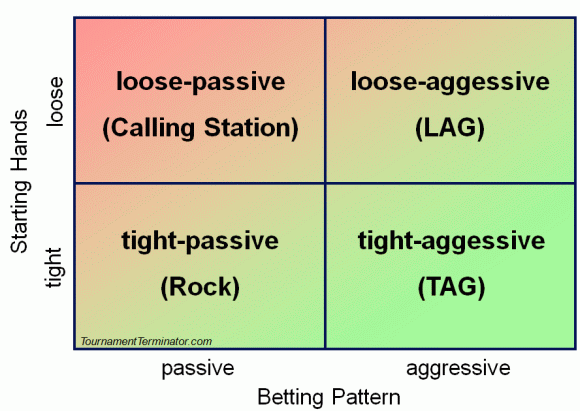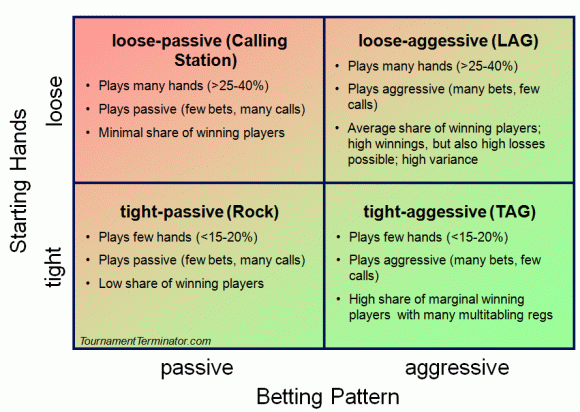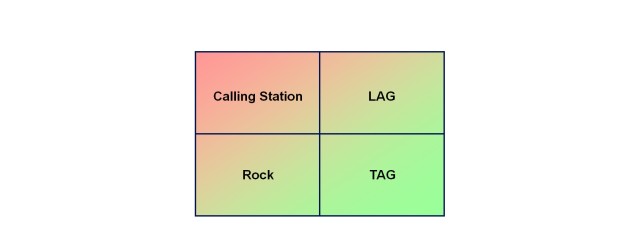Recommended Poker Room
Most of you will have heard terms like “Calling Station”, “TAG” or “Rock” – these are poker opponent classifications and terms for different poker playing styles. We will discuss the four basic types of opponents at the poker table in this strategy article. You will also learn the advantages and disadvantages of the various playing styles and we will give you tips on the best strategies to use against such players.
Classification of Poker Playing Styles / Opponents
There are two basic distinguishing features in the playing style of opponents:
- Starting hands: Does the opponent plays a lot of hands (loose) or only few starting hands (tight)?
- Betting pattern: Does the opponent (in relation to its calls) bet frequently (aggressive) or only rarely (passive)?
With starting hands, we mean the two hole cards that an opponent is not folding pre-flop. A tight player has strong requirements to the quality of his starting hands, a loose players plays many of the hole cards he gets. A poker player who plays the top 40% of the starting hands (33 +, A2 +, K2S +, K5o +, Q5s +, Q8o +, J7s +, J9o +, T8s) is loose, while a poker player who only plays 15% of the starting hands (55 + A7S + , A5s, A9o +, K9s +, KJo +, QJs) is tight.
The betting pattern is the relationship between betting and raising to calling. Checking is not considered. So you add the number of bets and raises of an opponent and put them in relation to the number of his calls (the formula is (number of bets + raises) / number of calls). If an opponent bets or raises twice as often as he calls, he is playing aggressive. If an opponent bets or raises less often than he calls bets, he is playing passively.
From the requirements on the starting hands and betting patterns we can derive four basic poker playing styles:
- Tight-passive: The Rock
- Tight-aggressive: The TAG
- Loose-passive: The Calling Station
- Loose-aggressive: The LAG
These four types of players can easily be displayed in a 2 × 2 matrix:

We will now elaborate on the four types of poker players in more detail.
The Rock (tight-passive)
A Rock only plays few hands and is a player who rarely bets and very rarely raises. If you get action from such a player, you can almost be sure that he holds a strong hand.
Benefits of tight-passive play
- Limitation on the good starting hands, which normally reduces losses
- If many aggressive players sit at the same table, this is a good strategy, because the other players will take care of betting and bluffing. Therefore, a rock can get action without having to bet by himself (which would make attentive players fold)
Disadvantages of the tight-passive play
- By his passive way of playing, a Rock is not getting the maximum profits from good hands. Furthermore, he is giving opponents the chance to draw him out on dangerous boards (e.g. if there is a risk that an opponent can complete his flush or his straight), as he does not protect his strong well enough
Optimal strategy for playing against a Rock
- If he is sitting in the blinds, try to steal the blinds with a 3BB raise from late position
- If a rock bets or even raises preflop you should only play the very best starting hands and fold the rest of the hole cards
- If you have a drawing hand on the flop, checking is usually the best strategy. As a Rock rarely bets, you will often get to see the next board card “for free”
The Calling Station (loose-passive)
A calling station plays a lot of starting hands, but rarely bets or raises. Many beginners play this style, often with the slogan “I’m having a look at the flop – any two cards can win!”. If they hit the flop, they are not betting because they fear that their opponents fold. If they miss the flop, they call bets anyways because they either could hit on the turn or because the opponent could be bluffing. It is virtually impossible to play this loose-passive style and make a profit in online poker.
Benefits of the loose-passive play
- If many aggressive players sit at the same table, they can take care of the betting
- Against a number of tight and passive poker players and if the effective stacks are very large (more than 100 or 200 big blinds), this strategy can profit from high implied odds (the opponents will hardly fold their top pair against a Calling Station who flops a straight with T8 offsuited)
Disadvantages of the loose-passive play
- Like as the Rock, the Calling Station is not getting the maximum profit from his strong hands and is not sufficiently protecting his made hands against draws
- Since this player type also plays too many weak hands, he constantly has the risk of only holding the second best hand in the game (eg, AT vs AK on a board like K-T-4 or A-J-2)
Optimal strategy for playing against a Calling Station
- Against a Calling Station you should only bet if you have good hands, do not try to bluff a Calling Station as he will call your bluffs anyway
- With strong hands, try to make higher than usual pre-flop raises if the Calling Station is already in the hand or sitting in the blinds
- If a loose-passive player bets, you should fold your medium strength hands
The TAG (tight aggressive)
A TAG plays few hands and is a player who frequently bets or raises, but only rarely makes calls. Most multitabling-regulars in SnG’s and MTT’s play this style of poker.
Benefits of tight-aggressive playing style
- Restriction on the good starting hands, which limits losses and simplifies the game (important for multi-tabling)
- Thanks to the aggressive play a successful strategy, since a TAG can either win by holding the better hand or by making the opponent fold
Disadvantages of the tight-aggressive playing style
- Due to the tight playing style the hand ranges of a TAG become easily readable. Attentive opponents will quickly adapt their game to TAG players
- There is an increased risk to lose the whole stack when holding a strong, but not very strong hand such as top pair, top kicker
Optimal strategy for playing against a TAG
- As he plays tight, try stealing his blinds if you are sitting in late position
- If a TAG bets or raises pre-flop, you should fold all but the very best starting hands. Play these hands aggressively and always re-raise with AA, KK, QQ (and sometimes JJ and AKs)
- If you play out of position against a TAG and hold a strong hand, then check to him on the flop: TAGs usually make continuation bets, regardless whether they hit the flop or not
- Overall, a tight-aggressive strategy in poker in the most profitable one. Try to learn the TAG strategy by yourself and try to avoid or limit the number of TAG players at your table
The LAG (loose aggressive)
A LAG plays many hands and is a player who frequently bets and raises, but only rarely calls bets. Some poker tournament pros use this strategy with great success, but this is also a high-risk strategy and should not be used by inexperienced players.
Benefits of the loose-aggressive style of play
- Because of playing many different starting hands, it is difficult to have a read on a LAG player
- The image of playing loose-aggressive can make opponents wrongly assume that the LAG is always bluffing
- Thanks to aggressive play a successful strategy, because a LAG can either win with the best hand or by making his opponent fold
Disadvantages of the loose-aggressive style of play
- A LAG must be able to know when he is beaten and fold his hands (which will often be the case), otherwise he will lose lots of money with this strategy
Optimal strategy for playing against a LAG
- If you’re a good player yourself, you can play more hands than usual against a LAG, as you will usually be a pre-flop favourite against his wide range of starting hands
- When a LAG bets before the flop, you can raise with your strong hands in order to isolate him
- If the LAG has position on you, you can often check and wait to raise his bets
The Nit and the Maniac
In addition, there are two other common types of poker players
- The Nit: a coward who folds most of the very few (<15%) starting hands he plays to bets from opponents. Many Rocks and some TAGs are Nits. If a Nit calls your bet, you can assume that he has a strong hand
- The Maniac: a very loose and very aggressive player. Against a Maniac, it is important to avoid tilt if he wins with cards like 64s. Stay cool, in the long run he will lose all his chips to other players at the table
Summary
We have seen that for most players, the tight-aggressive strategy is the best choice of the four presented strategies. Here is summary with the classification of the four possible opponent playing styles, including the advantages and disadvantages of the different strategies:

Knowing your opponents and knowing how to play against them is an important skill in poker to increase your profits. A much easier way to increase your profits is to grab yourself a high bonus from a poker room. Check out our exclusive bonus offerings now!
TIP: Full Tilt and Stars are both closed to US players. The best alternative for US players is Betonline Poker. Get your $2000 bonus on signup now!

 www.
www.
Every weekend me and my friends meet to play some games and our favorite one is poker. To tell the truth, during this game we are completely immersed in the process because it is really addictive game. To tell the truth, I can say that we have already mastered many poker games and now we are looking for something new and breathtaking. I’m certain that with the aid of your article we will be able to do it and feel excited emotions. All mentioned games seem so complicated and entertaining at the same time, but my favorite one became DEUCE-TO-SEVEN TRIPLE DRAW game because the strategy and rules of it are so special and reading an opponent’s hand is really atypical for me, but it makes me curious, as a player. It will be the first game between the mentioned ones that we try.